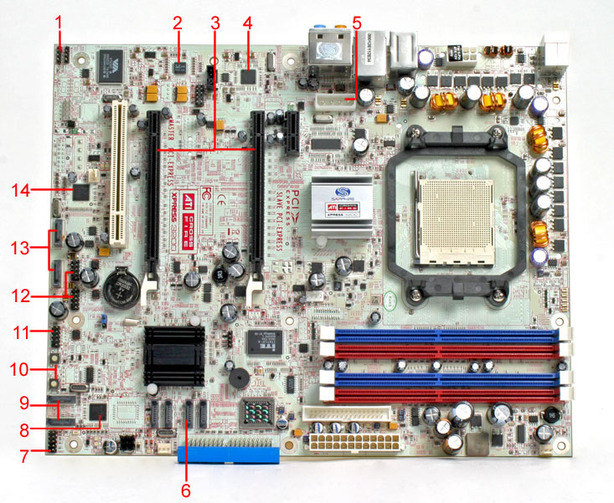

You may notice that the board's PCB is really as far as it gets with regards to being pure. The colour scheme is pseudo black and white, but comes with a blue IDE port, a silver northbridge and black southbridge, making the board feel a little less than pure. Although there is colour differentiation on the memory slots, there is absolutely no colour-coding between the USB pins, Firewire pins and front I/O panel pins: they are all in generic black plastic so the manual or some real close inspection is required for differentiation. That's not easy if you've installed your motherboard in your case, have wires routed and a couple of Radeons plugged in ready for some CrossFire action.
The single PCI slot is lost when using a dual slot cooler on the second video card in a CrossFire configuration. The bottom slot says "Master" but it's referring to when using the board in CrossFire mode for the master card, it's not indicating that this is slot one. When using a single card you can use the slave slot without issue, freeing up plenty of space for the PCI slot.
The large three slot gap between the two PCI-Express x16 slots is somewhat excessive and whilst this means with installing a PCI-Express card in the top you don't lose any slots, there could still be enough room for a couple of PCI or PCI-Express being used. Indeed, even below the bottom PCI slot there would be enough room for another PCI slot if it had been factored in during the design stages, and there are solder points for an unused PCI-Express x1 slot above the bottom PCI-Express x16 slot.
So, why not include them? Back at Computex, Sapphire told us that the clear path between the two PCI-Express slots was to allow for the best possible signal integrety when using the board for CrossFire. The thing is though, no board with additional slots between the two X16 slots seems to have major problems. If there were problems, motherboard manufacturers would have followed Sapphire's lead by now. The I/O slot layout isn't the only place where we think there is room for improvement: the rear I/O has a massive gap because the voltage regulation components have been moved across to the edge of the board, the CPU has been pushed over and rotated and the northbridge forced upwards from the missing components underneath.
Sapphire also includes two Sil3132 RAID controllers for a total of eight SATA 3Gbps ports which is nice and useful, but the second one is at the expense of an arguably more useful PCI slot. Sapphire has used two PCI-Express Sil3132s rather than a single PCI based 3124 because it requires fewer traces than the larger Sil3134 controller, despite it being a single chip four-port solution. The sad fact is that if Sapphire had worked in a Sil3134 controller, it would have been a lot more elegant and there would have been more available space for a second PCI slot as well as RAID 5 support. Obviously, motherboard design isn't quite as simple as that, but it does make us wonder why this option wasn't considered.
There are little funky red surface mount LEDs all over the board to tell you what's going on. It's almost mesmerising to actually watch your board work because ports that are data transfer based actually flicker when something is going on. There are five LEDs for PWMs, Power LED, Primary IDE LED, Standby LED and an LED for each SATA port. It's a shame that there is no option to route the signal from these activity LEDs elsewhere.
Passively cooled chipsets are always a plus for keeping your sanity, as is the inclusion of half decent sound from the high end Realtek ALC882D codec, which includes Dolby Digital Live that has to be used through the included S/PDIF PCI bracket. There is also standard support for 7.1 channel HD audio up to 192KHz and 24-bit fidelity as well. No secondary Gigabit Ethernet or even a WiFi option is disappointing considering this is Sapphire's flagship model. Compared to the competition that isn't an optimal choice. However, many will question whether you actually need more than one Ethernet socket on a board like this.
The IDE, SATA, floppy, fan headers and ATX power plug are well placed at the inside edge of the board but the 12V extra power is placed on where the rear I/O panel would be. This means you have to get the cable bent around the CPU socket from the other side of the board and although it is quite close to the top, it isn't optimal for the end user installing into a case.

MSI MPG Velox 100R Chassis Review
October 14 2021 | 15:04







Want to comment? Please log in.